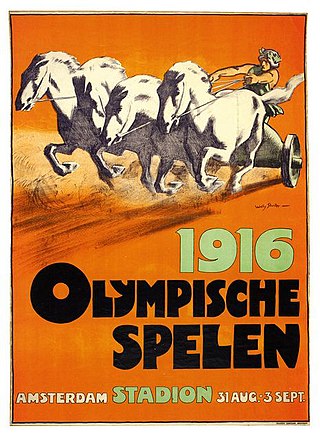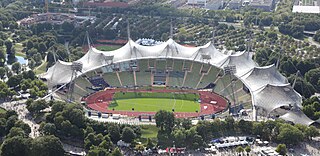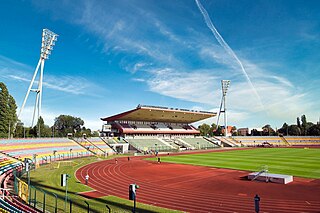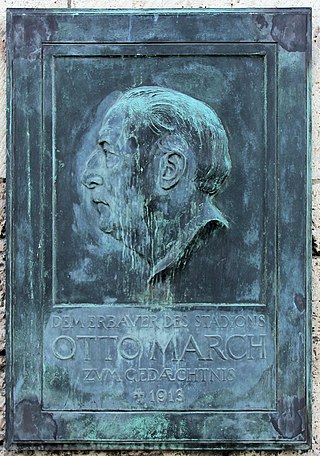
The 1916 Summer Olympics, officially known as the Games of the VI Olympiad, were scheduled to be held in Berlin, Germany. However, they were cancelled due to the outbreak of World War I, the first time in their twenty-year history of the games. Berlin was selected as the host city during the 14th IOC Session in Stockholm on 4 July 1912, defeating bids from Alexandria, Amsterdam, Brussels, Budapest and Cleveland. After the 1916 Games were cancelled, Berlin would eventually host the 1936 Summer Olympics, twenty years later.

The Olympiastadion, also known in English as the Berlin Olympic Stadium or simply the Olympic Stadium, is a sports stadium at Olympiapark Berlin in Berlin, Germany. It was originally designed by Werner March for the 1936 Summer Olympics. During the Olympics, the record attendance was thought to be over 100,000.

Olympiastadion is a stadium located in Munich, Germany. Situated at the heart of the Olympiapark München in northern Munich, the stadium was built as the main venue for the 1972 Summer Olympics.

The Helsinki Olympic Stadium, located in the Töölö district about 2.3 kilometres (1.4 mi) from the centre of the Finnish capital Helsinki, is the largest stadium in the country. The stadium is best known for being the centre of activities in the 1952 Summer Olympics. During those games, it hosted athletics, equestrian show jumping, and the football finals.
The Deutsches Stadion was a monumental stadium designed by Albert Speer for the Nazi party rally grounds in Nuremberg, southern Germany. Its construction began in September 1937, and was scheduled for completion in 1943. Like most other Nazi monumental structures, however, its construction was interrupted by the outbreak of World War II and was never finished.

Werner Julius March was a German architect, son of Otto March (1845–1913), and brother of Walter March, both also well-known German architects. Werner March designed Germany's 1936 Olympic stadium. Werner March was born in Charlottenburg and died in Berlin.

Stadion der Weltjugend was a multi-use stadium in the locality of Mitte in the eponymous borough of Mitte in Berlin, Germany. It was inaugurated on 20 May 1950 by the First Secretary of the Socialist Unity Party, Walter Ulbricht for the first "Deutschlandtreffen of the Free German Youth. The stadium was named after Walter Ulbricht. In the vernacular of Berlin, the stadium was later called Zickenwiese after Ulbricht's beard.

Fascist architecture encompasses various stylistic trends in architecture developed by architects of fascist states, primarily in the early 20th century. Fascist architectural styles gained popularity in the late 1920s with the rise of modernism along with the ultranationalism associated with fascist governments in western Europe. Fascist styles often resemble that of ancient Rome, but can extend to modern aesthetics as well. Fascist-era buildings are frequently constructed with particular concern given to symmetry; simplicity; and monumental size, especially for public buildings.

Sportforum Hohenschönhausen, officially named Sportforum Berlin, is a multi-purpose sports complex in the locality of Alt-Hohenschönhausen of the borough of Lichtenberg in Berlin. The Sportforum was also known as the Dynamo-Sportforum during the East German era.

Westend is a locality of the Berlin borough Charlottenburg-Wilmersdorf in Germany. It emerged in the course of Berlin's 2001 administrative reform on the grounds of the former Charlottenburg borough. Originally a mansion colony, it is today a quite densely settled, still affluent territory adjacent to Berlin's inner city in the east.

The Friedrich-Ludwig-Jahn-Sportpark is a multi-purpose sports complex located in the western part of the locality of Prenzlauer Berg in the borough of Pankow in Berlin. The sports complex covers an area of approximately 22 hectares and comprises several facilities. The main building is the Friedrich-Ludwig-Jahn-Stadion. The stadium is the third-largest stadium in Berlin, after the Olympiastadion and the Stadion An der Alten Försterei, with a capacity of approximately 20,000 seats, of which 15,000 are covered. Currently, the main tenants of the stadium are VSG Altglienicke and Berlin Thunder. Friedrich-Ludwig-Jahn-Sportpark was the venue for the 2018 World Para Athletics European Championships.

Football in Berlin, the capital of Germany, has a long history. The city contributed 24 of the 86 founders of the DFB, the German Football Association. The DFB Cup Final has been held every year at the Olympiastadion since 1985.

Heerstraße is a railway station in Berlin, Germany. It is located on the Spandau Suburban Line in the Westend district and served by S-Bahn S3 and S9 trains. The station is today listed as a historical monument.

Olympiastadion is a railway station in the Westend district of Berlin. Located at the southern entrance of the Olympic Stadium, it is served by the S-Bahn lines S3 and S9. The station consists of one island platform which is in regular use, as well as four further terminal island platforms which are only used for the extra trains during major events.

Central Stadium was a stadium with a capacity of 120,000 in Leipzig which was initially used for matches of SC Rotation Leipzig.

The Poststadion is a multi-use stadium in the locality of Moabit of the borough of Mitte in Berlin, Germany. The stadium was built in 1929 for the sports club of the German Reichspost at the site of a former Prussian Uhlan parade ground. It is adjacent to the Fritz Schloß Park.

The Spandau suburban railway is a suburban railway in Berlin. It is an extension of the Stadtbahn from Westkreuz to Spandau. Its last kilometre runs parallel with the Lehrte and Hamburg lines. It is currently used by Berlin S-Bahn lines S3 and S9.

Berlin is a major sporting centre in Germany and Europe. In 2013 around 600.000 Berliners were registered in more than 2.300 amateur sports- and fitness clubs.

Olympiapark Berlin, previously the Deutsches Sportforum and the Reichssportfeld, is a sports and entertainment complex located in Berlin, Germany. The complex served as the Olympic Park of the 1936 Summer Olympics.

Otto March was a German architect and father of architects Werner March (1894–1976) and Walter March (1898–1969).





















